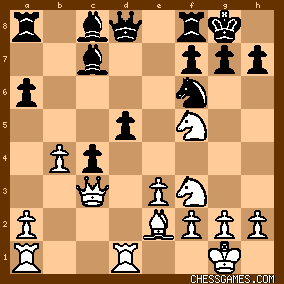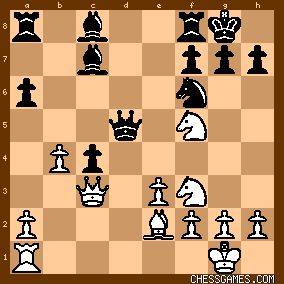|
< Earlier Kibitzing · PAGE 3 OF 5 ·
Later Kibitzing> |
| Jan-30-06 | | OKKarpovisgreat: Even 'Child of Change', Tamud?
You might be able to get some nose
candy money for that at a pawn shop. |
|
| Mar-13-06 | | Fast Gun: It may well be true that Kasparov has played the bulk of his chess during the past 20 years against the top ten to fifteen players in the world, but that can be little doubt that even if were to lose the occasional game to a GM rated 2500 approx he would surely defeat them in a match of six games or above: |
|
| Mar-13-06 | | Brown: 20...Qc8 is an alternative as well |
|
| May-17-06 | | Seethamraju: In the 21st move why did not kasparov captured the Rook with his Queen?? |
|
| May-17-06 | | ganstaman: 21...Qxd5 22. Ne7+ Kh8 23. Nxd5
So if Kasparov took the rook, Huzman would get his queen at the least. There may be more, but I think this is sufficient reason. |
|
| May-19-06 | | Seethamraju: <averageguy>I does not agree with you that he is over-confident.He must be having some personal problem,a family problem I think. |
|
| May-22-07 | | nummerzwei: Maybe he just didn´t realize that his opening preparation was already over on move 20-it usually isn´t. |
|
| May-29-07 | | whatthefat: Admittedly a bad result for Kasparov, but would people be going so crazy over a 1574 beating an 1830? I think not. Yet given the form of the Elo system, such a result is just as likely. |
|
May-29-07
 | | JointheArmy: <Yet given the form of the Elo system, such a result is just as likely.> No its not, because in 2003 the K-factor for everyone above 2400 equaled 10 meaning the lower it is the harder it is to get a good picture based on recent performance. Huzman might have been performing at a much higher level, but since the K-factor is too low for 2400+, it takes a few more games for performance to catch up. If Huzman were 1500 and Kasparov 1800 the ELO's are more dynamic and probably more accurate considering the higher K-factor so the result would not be the same statistically as everyone above 2400+. Also they changed the K-factor again according to the FIDE handbook just recently. |
|
| May-29-07 | | whatthefat: <JTA>
Sorry, what's your point? Are you saying that because their ratings are more reliable, a 1500 beating an 1800 is even less likely than Huzman beating Kasparov? If anything you could perhaps argue the opposite, since presumably to reach 2500+ one has to be a 1500-1800 level player at some point, and ability (and hence rating) has a habit of converging over time, rather than increasingly fluctuating. My point is that a 300 point rating difference is considered equivalent under the Elo system in terms of expected results, regardless of ratings, i.e., an 1800 will beat a 1500 as regularly as a 2800 beats a 2500. Of course when a player's rating has not yet converged to their skill level the system can not be reliable; but I can think of several instances where a long time 1500-level club player has beaten a long time 1800-level player in a tournament, and nobody has cried out that the sky is falling down. |
|
May-29-07
 | | JointheArmy: <whatthefat> I'm saying there's a difference between a 1500 and 1800 and a 2500 and 2800 due to the K-factor. I didn't argue this <Are you saying that because their ratings are more reliable, a 1500 beating an 1800 is even less likely than Huzman beating Kasparov?> so before you jumped to this straw man (?) <If anything you could perhaps argue the opposite, since presumably to reach 2500+ one has to be a 1500-1800 level player at some point, and ability (and hence rating) has a habit of converging over time, rather than increasingly fluctuating.> stop and see I'm just pointing out that your statement <Yet given the form of the Elo system, such a result is just as likely.> wasn't true since that slight difference means it takes more games for a 2400+ to be closer to his actual rating if there's a slump, improvement, decline, etc. I didn't indicate anything other than that. Also if the wording or somehow it sounded like I did, then my apologies, I just want you to acknowledge the difference. I don't want this to turn into an ego war of I'm right and your wrong kind of argument, so let's handle this politely :-). |
|
| May-30-07 | | whatthefat: <JTA>
I wasn't looking for an argument. I honestly couldn't see what the point you were making was. Now I see, but I don't think I agree. Sure, when a player is at a stage in their career when their level of skill is rapidly changing (i.e., on the scale of weeks to months), the size of the K-factor will play a large role in matching rating to skill level. But once that general trend has settled down and changes in overall skill are occuring on a much longer time scale (i.e., most GMs), the K-factor will no longer play as important a role. At that point, the biggest source of discrepancy between skill and rating will be the day to day fluctuations in form, which are much too rapid for any reasonable K-factor to capture, and so provide a limit on the accuracy of the rating. Thus, once a player settles into their 'true' rating, I believe it ought to be similarly reliable, whether it's 1500 or 2500, since the K-factor is no longer the dominant effect. In retrospect though, one could argue contrary to my point from a purely chess perspective, since the nature of the game changes at a higher skill level. A 2800 may beat a 2500 by the same margin on average that an 1800 beats a 1500 by, but the error rate and therefore the number of decisive games will be very different (as confirmed by the number of draws at the top level compared to club level). In that respect, I suppose it's more likely that a 1500 will beat an 1800 than that a 2500 will beat a 2800. |
|
| Jul-05-07 | | sanyas: It is a pretty nice shot though, has it been a puzzle yet? |
|
| Apr-29-08 | | sallom89: ouch.. the rating difference was a lot :/ |
|
| Apr-29-08 | | James Demery: I wonder how many rating points Huzman gained from this win? |
|
| Apr-29-08 | | lost in space: Ouch!! Who the heck is Huzman? Never heard of him before and after this game. |
|
| Apr-29-08 | | sallom89: <James Demery: I wonder how many rating points Huzman gained from this win?> i wish to know the answer too lol.. hope <frogbert> calculate it :P |
|
| May-23-08 | | AAAAron: The word on the street is that Kasparov ate bad sushi the night before, so he had the runs and couldn't stop sweating. |
|
| May-23-08 | | Riverbeast: Bad sushi in Crete?
The word on the street I heard, is Huzman ate some 'tzatziki' that day and it was GOOD....He washed it down with some 'retsina' then sat down and busted Kasparov's ACE |
|
| Jul-03-08 | | AAAAron: <Riverbeast>
hahaha, we obviously have different street sources. |
|
| Jul-17-08 | | The Ninth Pawn: From Game Collection: The Ninth Pawn's Chess Course : In Huzman vs Kasparov, 2003 , the two ideas are the PIN and the KNIGHT FORK. After 21. ♖d1x♙d5! the rook is untouchable because the knight is pinned to mate at g7 and the queen is preventing 22. ♘f5-e7+. |
|
| Sep-09-08 | | ravel5184: Huzman vs Kasparov, 2003 Position after 20 ... Bc8:

click for larger viewWhite's next move is just a great example of both the use of a <PIN> and a <DECOY> into a <FORK>. 21. Rxd5!
The brilliant <TACTICAL POINT> behind this move is that both the Queen <AND> the Knight are <TIED DOWN> meeting <GREATER THREATS>. (1) the <MATE THREAT> on g7 <TIES DOWN> the Knight to the f6-square, (2) the <KNIGHT FORK THREAT> that <PREVENTS> the Queen from going to d5. Position after 21. Rxd5!

click for larger view(VAR) 21 ... Qxd5? 22. Ne7+

click for larger view
click for larger view(VAR) 21 ... Nxd5?? 22. Qxg7#

click for larger view
click for larger viewFor more <notyetagm>-inspired analysis visit my forum. |
|
| Dec-21-08 | | WhiteRook48: what was Kasparov doing here? |
|
| Jan-07-09 | | WhiteRook48: Kasparov blunders two pawns. Was he trying to improve his bishop at c8? |
|
| Feb-07-09 | | WhiteRook48: repositioning your bishop may not be the best thing |
|
 |
 |
|
< Earlier Kibitzing · PAGE 3 OF 5 ·
Later Kibitzing> |





